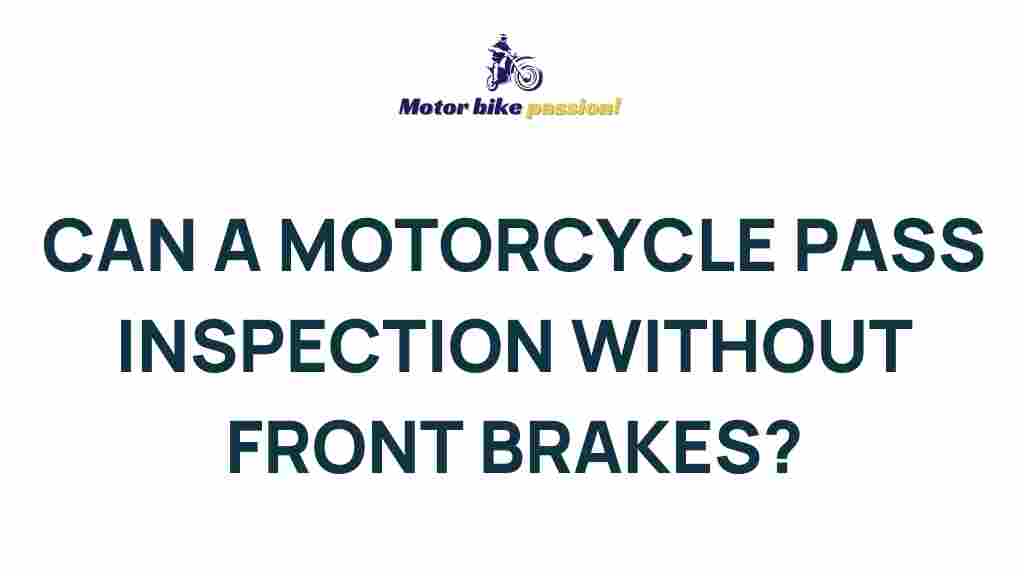Unraveling the Mystery: Can a Motorcycle Pass Inspection Without Front Brakes?
When it comes to motorcycle safety and regulations, one of the most crucial components is the braking system. A question that often arises among motorcycle owners is whether a motorcycle can pass inspection without front brakes. This article explores the regulations surrounding motorcycle inspections, the safety implications of not having front brakes, and what you can do to ensure your motorcycle passes inspection.
Understanding Motorcycle Inspection Regulations
Motorcycle inspections are designed to ensure that vehicles on the road meet safety standards. Each state in the U.S. has different regulations regarding what is required for a motorcycle to pass inspection. However, most states have common requirements, including:
- Functional brakes (both front and rear)
- Working lights (headlights, brake lights, turn signals)
- Tires in good condition
- Properly functioning mirrors
- Exhaust systems that meet noise and emissions standards
Given these requirements, it’s clear that the braking system is a critical component of motorcycle safety. Let’s delve deeper into the implications of not having front brakes.
The Importance of Front Brakes
Front brakes are essential for motorcycle safety for several reasons:
- Stability: Most of a motorcycle’s stopping power comes from the front brakes. Without them, the bike can become unstable.
- Control: The front brakes provide better control during sudden stops or emergency braking situations.
- Weight Distribution: Braking shifts the weight of the motorcycle. Without front brakes, the rear brake alone may not provide adequate stopping power.
These factors highlight why having functional front brakes is not just a matter of passing inspection, but also of ensuring rider safety.
Can a Motorcycle Pass Inspection Without Front Brakes?
In most cases, a motorcycle cannot pass inspection without front brakes. Most inspection regulations require both front and rear brakes to be operational. If your motorcycle is missing front brakes or if they are malfunctioning, it is unlikely that you will be able to pass inspection. Here are some specific points to consider:
State Regulations
Each state has its own motorcycle inspection rules, so it’s essential to check the specific regulations pertaining to your location. Generally, inspectors will look for:
- Brakes must engage properly when activated.
- Brake pads must be within acceptable wear limits.
- Hydraulic systems must not leak.
For example, in states like California and Texas, both front and rear brakes must be fully functional for a motorcycle to pass inspection.
Exceptions to the Rule
While it’s rare, some states may have exceptions for certain types of motorcycles or special circumstances. For instance, vintage bikes or motorcycles that are not designed for street use might have different regulations. However, it is always advisable to verify with your local Department of Motor Vehicles (DMV) or similar authority.
Step-by-Step Process for Preparing for Motorcycle Inspection
To ensure your motorcycle is ready for inspection, follow these steps:
- Check Your Brakes: Inspect both front and rear brakes for functionality. Ensure that the brake pads are not worn down and that the brake fluid is at the proper level.
- Inspect Other Safety Features: Check that your lights, signals, and mirrors are operational and comply with your local regulations.
- Examine Tires: Ensure your tires have sufficient tread and are free from damage.
- Review Emission Standards: Make sure your exhaust system meets local emissions regulations.
- Consult Your Mechanic: If you’re unsure about the condition of your brakes or any other components, take your motorcycle to a qualified mechanic for a thorough inspection.
Troubleshooting Tips for Brake Issues
If you find that your front brakes are not functioning correctly, consider the following troubleshooting tips:
- Check Brake Fluid: Low or contaminated brake fluid can affect brake performance. Ensure that the fluid is clean and at the right level.
- Inspect Brake Pads: Worn brake pads will need to be replaced. Check for thickness and replace if necessary.
- Look for Leaks: Check brake lines and calipers for any signs of leakage, which can compromise brake function.
- Test the Brake Lever: Ensure that the brake lever engages and releases properly. If it feels spongy, there may be air in the brake lines that needs to be bled.
Addressing these issues before your inspection can help ensure that your motorcycle passes and remains safe to ride.
What to Do If You Fail Inspection
If your motorcycle fails inspection due to brake issues, don’t panic. Here’s what you can do:
- Identify the Problem: Review the inspection report to understand why you failed.
- Make Necessary Repairs: Address any issues, particularly with the front brakes, as this is likely the primary reason.
- Re-inspect: Once repairs are made, have your motorcycle re-inspected as soon as possible.
Failing to address brake issues can not only prevent your motorcycle from passing inspection but can also compromise your safety on the road.
Conclusion
In conclusion, a motorcycle cannot pass inspection without front brakes in most cases, as regulations universally mandate that both front and rear brakes be in working order for safety reasons. Ensuring that your motorcycle is equipped with functional front brakes is critical not only for passing inspection but also for your safety while riding.
By understanding the regulations, preparing your motorcycle properly, and addressing any issues proactively, you can navigate the inspection process successfully. For further information on motorcycle safety and regulations, check out resources from your local DMV or the National Highway Traffic Safety Administration (NHTSA).
Riding a motorcycle comes with inherent risks, but with proper maintenance and adherence to safety regulations, you can enjoy the ride while keeping yourself and others safe on the road.
For more tips about motorcycle maintenance and safety, visit our Motorcycle Maintenance Guide.
This article is in the category Safe Driving and created by MotorBikePassion Team
